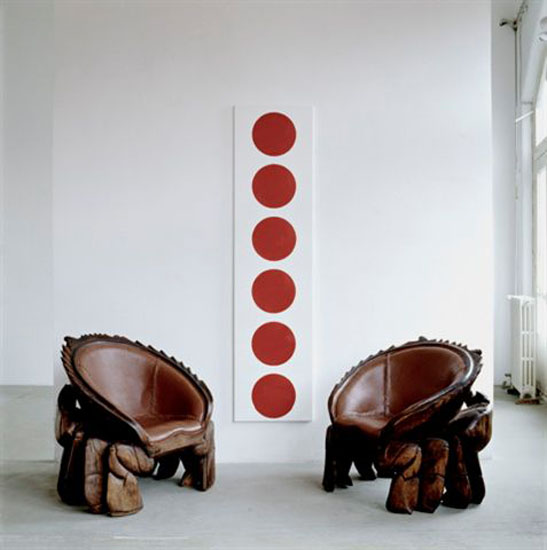John M Armleder
.
THE FULL STOP

John M Armleder, Furniture Sculpture 189, 2000. Balinese chairs of wood, untitled painting, 231 x 231 x 125 cm

John M Armleder, Furniture Sculpture 189, 2000. Balinese chairs of wood, untitled painting, 231 x 231 x 125 cm
If there is one question which John M Armleder can't and does not want to answer, it is the question: what do you want people to see in your work? Critics have lauded his masterful use of different media and the sophisticated abstraction that informs his artistic process, but Armleder himself seems to be more concerned with a way of thinking than a sheer mechanics of doing. He begins with an idea, and the rest is a matter of consequence. The best way to demonstrate the drive behind Armleder's work is to illuminate the smallest, most obscure piece he ever made. It is the full stop, or rather, the absence of it, i.e. the full stop that is missing behind the M in his middle name. Since 1973, Armleder has been running Ecart Editions, a small publishing press in Geneva, and has been exposed to a lot of printed matter. Well-educated typesetters know that they are forbidden to make the slightest change in the copy coming in. Armleder found this code of accuracy extremely interesting, and he decided to shorten his middle name, Michael, to an M without a full stop at the end. In this winking way, he could find out what kind of printer he was dealing with when he outsourced his own publications. That full stop, essentially a private joke told to himself, has been used by Armleder in all his works to this day.
Whether in the print or art world, Armleder has always challenged orthodox practice, and his own artistic process yields its own surprises. 'I can only confess being always close to mesmerized by the quasi-stupidity which qualifies the formal problems depicted in my pieces', Armleder said to Helmut Federle in a 1985 interview. 'But they do excite me enough to get through with them, and the whole process each time shakes the complete system of values I thought I had understood before'. Armleder's readiness to embrace a negation of what he has discovered before is his great strength. This adaptability, above all, makes his art what it is: studied yet casual, a marriage of high and low brow, and in the last run nothing but the product of a studied intelligence.
Kees van Gelder (this text was published in NY Arts Magazine, September - October 2008)
